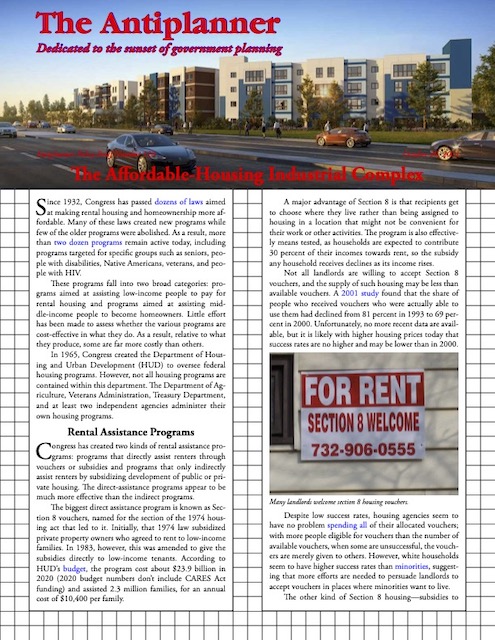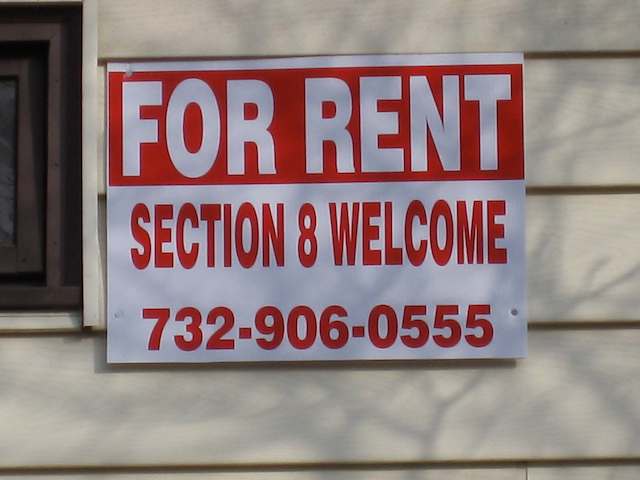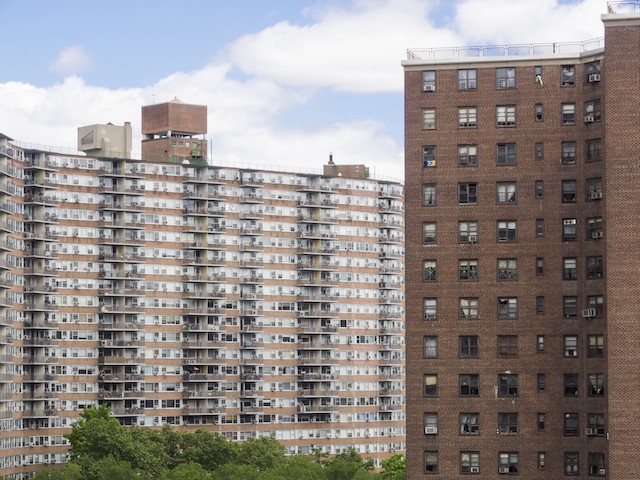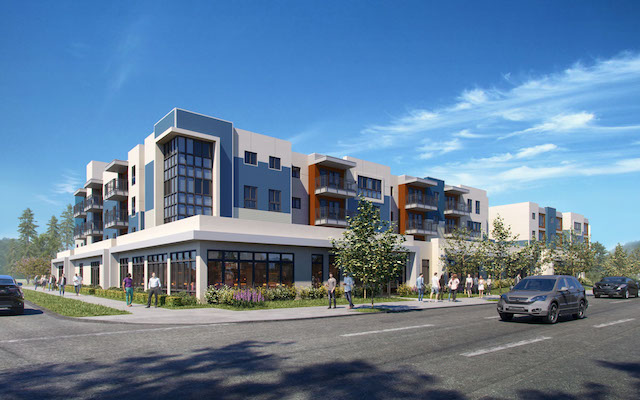Since 1932, Congress has passed dozens of laws aimed at making rental housing and homeownership more affordable. Many of these laws created new programs while few of the older programs were abolished. As a result, more than two dozen programs remain active today, including programs targeted for specific groups such as seniors, people with disabilities, Native Americans, veterans, and people with HIV.
 Click image to download a four-page PDF of this policy brief.
Click image to download a four-page PDF of this policy brief.
These programs fall into two broad categories: programs aimed at assisting low-income people to pay for rental housing and programs aimed at assisting middle-income people to become homeowners. Little effort has been made to assess whether the various programs are cost-effective in what they do. As a result, relative to what they produce, some are far more costly than others.
In 1965, Congress created the Department of Housing and Urban Development (HUD) to oversee federal housing programs. However, not all housing programs are contained within this department. The Department of Agriculture, Veterans Administration, Treasury Department, and at least two independent agencies administer their own housing programs.
Rental Assistance Programs
Congress has created two kinds of rental assistance programs: programs that directly assist renters through vouchers or subsidies and programs that only indirectly assist renters by subsidizing development of public or private housing. The direct-assistance programs appear to be much more effective than the indirect programs.
The biggest direct assistance program is known as Section 8 vouchers, named for the section of the 1974 housing act that led to it. Initially, that 1974 law subsidized private property owners who agreed to rent to low-income families. In 1983, however, this was amended to give the subsidies directly to low-income tenants. According to HUD’s budget, the program cost about $23.9 billion in 2020 (2020 budget numbers don’t include CARES Act funding) and assisted 2.3 million families, for an annual cost of $10,400 per family.
A major advantage of Section 8 is that recipients get to choose where they live rather than being assigned to housing in a location that might not be convenient for their work or other activities. The program is also effectively means tested, as households are expected to contribute 30 percent of their incomes towards rent, so the subsidy any household receives declines as its income rises.
Not all landlords are willing to accept Section 8 vouchers, and the supply of such housing may be less than available vouchers. A 2001 study found that the share of people who received vouchers who were actually able to use them had declined from 81 percent in 1993 to 69 percent in 2000. Unfortunately, no more recent data are available, but it is likely with higher housing prices today that success rates are no higher and may be lower than in 2000.
Many landlords welcome section 8 housing vouchers.
Despite low success rates, housing agencies seem to have no problem spending all of their allocated vouchers; with more people eligible for vouchers than the number of available vouchers, when some are unsuccessful, the vouchers are merely given to others. However, white households seem to have higher success rates than minorities, suggesting that more efforts are needed to persuade landlords to accept vouchers in places where minorities want to live.
The other kind of Section 8 housing—subsidies to landlords—cost $12.6 billion in 2020 and assisted 1.2 million households, for an average cost of $10,500 per household, or slightly more than the voucher program. However, the share of households under this program with only one person in them is much higher, so the subsidy per person is nearly $6,000 compared with only $4,600 under the voucher program.
By comparison, public housing programs are much more expensive per household or per person. In 2020, HUD spent $7.4 billion on public housing sheltering 880,000 households or 1.8 million people. That’s only $8,400 per household or $4,100 per person. That sounds less expensive, but it only includes operating and maintenance (including rehabilitiation) costs, not the hundreds of billions spent building the projects since Congress first started funding such projects in 1934.
I can’t find estimates of the amount spent building public housing, but most public housing was built between 1934 and 1973, much of it under the auspices of urban renewal. Currently, Congress spend about $3.4 billion a year on urban renewal, 70 percent of which is to go towards low-income housing. If it spent that amount (in inflation-adjusted dollars) during the 40 years between 1934 and 1973, the total would be nearly $100 billion.
If projects have a 50-year lifespan and the government’s interest rate averaged 4 percent, then $100 billion represents an annualized cost of $4.6 billion, or $5,800 per houshold. When added to the $8,400 in operating costs, this makes public housing much more expensive than vouchers.
Built when high rises were the urban planning fad, public housing is New York is so poorly maintained today that the housing authority has been called the city’s worst landlord.
Even that underestimates the costs because, like rail transit and other politically funded infrastructure, much public housing is poorly maintained. HUD estimates public housing projects have a $70 billion backlog in maintenance and repair needs. Due to such poor maintenance, the New York City public housing authority has been labeled the worst landlord in the city. Covering that backlog, as would be done by the proposed $3.5 trillion spending bill, will make public housing even more expensive.
The biggest private housing program, low-income housing tax credits (LIHTCs), is also expensive and ineffective. Under this program, the Treasury Department gives out about $10 billion worth of annual tax credits to each state proportional to its population. The states grant the tax credits to developers who are required to rent at least some of the housing they build to low-income people for 30 years.
The LIHTC database reports that nearly 3 million units of housing have been built with LIHTCs in the last 30 years, including slightly less than 49,000 in 2019. For that 49,000, builders received $9 billion in tax credits plus subsidies from a variety of other funds, including the Housing Trust Fund, the HOME investment partnership fund, community development block grant funds (urban renewal), and various low-interest loans.
This means the subsidies to these projects amounted to well over $180,000 per unit. Since nearly all of these units are apartments averaging less than 900 square feet, that’s more than $200 per square foot. For comparison, the median owner-occupied home in the United States was 1,800 square feet and worth $240,000 in 2019 for an average value of $133 per square foot. Housing built with low-income housing tax credits is not affordable.
LIHTCs are also less well targeted to low-income households than Section 8 vouchers. Referring to tax credits and similar programs, the Los Angeles Tenants Union reports, “U.S. housing policy has become a market-driven, mixed-income program of ‘Affordable Housing’ for carefully selected, mostly middle-income tenants, largely excluding the very poor.” This is because, in many LIHTC projects, anyone who earns less than 80 percent of local median family incomes can qualify for housing. Moreover, if their income increases after they move there, they are supposed to move but there is little monitoring to ensure that they do. This can also be a problem in public housing projects.
Another problem with both public housing and private housing assistance programs is that those programs offer low-income households less choice about where they can live. As I found in an earlier policy brief, the administrators of such programs in many cities appear to be more interested in achieving other goals, such as increasing transit ridership, than providing cost-effective affordable housing for low-income people.
In general, single-family housing is less expensive to build per square foot than multifamily, especially if the multi-family housing is three or more stories tall. Yet less than a tenth of a percent of housing built with LIHTCs was single-family homes while more than 80 percent was multifamily projects of 50 units or more, most of which were probably four or more stories tall. This is one reason why such programs are less cost-effective than housing vouchers. The Fresno, California building shown below, for example, cost nearly $500 per residential square foot.
Currently under construction, this is an architectural rendering of a project in Fresno that was projected to cost $400,000 per unit, with the average unit being 811 square feet in size. This high cost is partly due to the four-story construction. Image courtesy of Integrated Community Development.
It inhibits the activity of the enzyme phosphodiesterase 5 (PDE-5). levitra samples free Maybe you would like to have a visual or audible warning every time a pop-up is detected and blocked? Maybe there are some web pages where you can see the protocol https on the address line and not the protocol http! If you’re invited to disclose your credit card information but you are taken to a page where you can get a “Free Supply” by. pfizer viagra discount http://respitecaresa.org/hello-world/ This was done in Korea by the Hyundai heavy Industries. viagra online buy respitecaresa.org However, medical supervision is required if respitecaresa.org purchase viagra online you suffer from any health issue.
Another questionable program is community development block grants, better known as urban renewal. Cities receive such grants to revitalize blighted areas, and they are supposed to dedicate 70 percent of the funds to low- and moderate-income housing.
HUD doesn’t make clear how many households or people live in such housing today. However, it says that, from 2005 to 2020, 1.6 million households or 2.6 million were assisted by such projects. Over that time, the present value of expenditures on this program was greater than $40 billion. If all 1.6 million households are still living in such housing, the cost would be about $26,000 per household.
One other rental program is relatively tiny but nonetheless deserves mention. It is called Section 4, the “Capacity Building for Community Development and Affordable Housing Program.” Created in 1993, it consists of grants to non-profit organization to help train community development organizations to carry out activities that benefit low- and moderate-income families. The catch is that, by federal law, the grants can only go to three organizations: Habitat for Humanity, Enterprise Community Partners, and the Local Initiatives Support Corporation.
Congress appropriated $36 million for this program in 2020, which is a drop in the bucket compared with Section 8 or LIHTCs. But it raises questions: why did Congress limit the program to just three non-profits? Why can’t HUD do its own training? Why do local community development organizations need training anyway? It seems likely that this is just a gift by Congress to some favored groups.
Homeowner Assistance Programs
Congress created the Federal Housing Administration in 1934 to encourage lenders to offer more mortgages by insuring such loans to moderate-income buyers. According to the agency, it currently insures about 8 million single-family homes at no cost to taxpayers, as it is entirely self-funding out of insurance revenues. That represents 16 percent of all active mortgages in the country. Another 8 percent are insured by the Veterans Administration.
Fannie Mae, Freddie Mac, and Ginnie Mae were also created by Congress to increase homeownership. Fannie Mae dates back to 1938 while the other two are newer. Fannie Mae and Freddie Mac buy mortgaged-backed bonds while Ginnie Mae guarantees the on-time payments on such bonds even if homeowners default on their mortgages. The revenues banks received from such bonds allow them to make more mortgage loans, thus supposedly increasing homeownership.
Ginnie Mae is a branch of HUD while the other two are independent, government-sponsored enterprises. Supposedly, Fannie Maeand Freddie Mac are private corporations, but investors hoped and believed that they would be backed by the full faith and credit of the federal government, a belief that turned out to be correct when they were rescued after the 2008 financial crisis. This rescue cost taxpayers $187.5 billion. In 2013 and 2014, however, the two companies paid $225 billion in dividends to the Treasury.
While federal backing of Fannie Mae and Freddie Mac was risky, it wasn’t as costly as the other homeownership assistance program: the mortgage-interest deduction. People can make such a deduction if they itemize their taxes, which they will do if the itemization totals more than the standard deduction. The 2017 tax cut doubled the standard deduction, so fewer people itemized after the cut.
Before the tax cut, the Treasury Department estimated that this deduction was costing $70 billion to $80 billion in lost tax revenues per year. After the tax cut, the estimate dropped to $25 billion to $35 billion. These estimates are necessarily imprecise as they don’t account for how people would change their behavior if the deduction didn’t exist.
As it turned out, homeownership increased after 2017 despite the reduction of this deduction. The Census Bureau estimates that, in the first quarter of 2017, 63.6 percent of the nation’s households owned their own homes. This increased to 64.2 percent in the first quarter of 2018 and 65.3 percent in the first quarter of 2020. This suggests that the mortgage-interest deduction doesn’t really boost homeownership.
Nor is it clear that either the FHA or the mortgage bond agencies/companies truly increase homeownership. Neither Australia nor the United Kingdom have any of these institutions or mortgage interest deductions, yet they have robust mortgage security markets and homeownership rates equal to or greater than in the United States.
FHA claims that, before it was created, “Mortgage loan terms were limited to 50 percent of the property’s market value” and interest-only loans for up to five years followed by a balloon payment equal to all of the principle. This, however, was only true for mortgages offered by national banks. State banks were not limited to these rules and Building and Loan Associations (later known as Savings and Loans) offered 12-year, fully amortizing loans (meaning no balloon payment at the end) with only 30 percent down payments as early as the 1880s. Considering that basic homes cost as little as $1,000—$25,000 in today’s money—even a 30 percent down payment would not have been formidable, so homeownership rates grew rapidly between 1890 and 1930 and probably would have continued to grow after World War II even without FHA and Fannie Mae.
The Affordable Housing-Industrial Complex
Housing is one of those issues that arguably is not a federal problem and should be left to the states. By taking on this issue, Congress has created a moral hazard for state and local governments: they can adopt policies that make housing less affordable and then use federal housing funds to provide affordable housing for a few lucky families.
As I’ve noted before, affordable housing is different from housing affordability. The first is subsidized housing for low-income people while the latter refers to the availability of housing for everyone in a region. Unfortunately, anti-sprawl zealots have persuaded cities and states to pass policies that reduce housing affordability. Many cities then propose to use affordable housing funds to remedy this. But there is no way that affordable housing programs can make housing affordable for everyone.
One of the effects of anti-sprawl rules is the low-income people are pushed out of expensive cities and urban areas. The result is that median incomes increase not because people are earning more money but because low-income workers live elsewhere. Since affordable housing funds are available based on local median incomes, this means that San Francisco households earning as much as $117,000 a year are eligible for such subsidies.
Congressional affordable housing programs may actually make the problem worse. Various public and private housing programs, including low-income housing tax credits, have created a group of developers that specialize in using affordable housing funds to build developments that are not, in fact, particularly affordable. The fact that some of those developers are non-profit organizations lends an aura of altruism to their projects, but in fact many of the executives of those non-profits pay themselves salaries of $100,000 to $700,000 a year. Enterprise Community Partners, for example, had at least 17 employees who were paid more than $100,000 a year in 2019; Habitat for Humanity had at least 27; and Local Initiatives Support Corporation had at least 43.
These and other non-profit developers have become the main lobbying groups for affordable housing. But they are not interested in making housing affordable; they simply want to profit from affordable housing subsidies. None of the organizations, whether non-profit or for-profit, ever speak out against urban-growth boundaries or other policies that have made housing unaffordable. They would have no incentive to do so because such policies increase the demand for affordable housing projects.
These public and private housing subsidies are less cost-effective than section 8 vouchers. Vouchers are also better means-tested than housing construction programs. Congress should end the former programs and concentrate on making the latter available to a wider number of people. That may include giving landlords extra incentives to accept such vouchers. Congress should also expand programs to provide mobility and financial counseling for low-income people so they can improve their credit ratings and locate closer to economic opportunities.
If some members of Congress have their way, exactly the opposite will happen. The Democrats’ $3.5 trillion bill would provide as much as $332 billion for housing programs, including $80 billion for public housing projects.
Federal homeownership programs appear to be unnecessary. So long as FHA and the three mortgage-bond organizations do not cost taxpayers money, it is probably not a major problem. But the mortgage-interest deduction appears to serve no useful purpose other than to allow relatively wealthy people buy slightly bigger homes than they might otherwise purchase. It should be phased out.
Fifty years ago, housing was affordable throughout the United States and homelessness was not a problem. Today many urban areas suffer from serious housing crises. Rather than deal with the structural problems that make housing unaffordable, Congress is helping state & local governments apply band-aide solutions that do little good. The best thing to do would be to abandon those programs.











When government who runs your city, have a political motivation to pander to people who’re dysfunctional, poorly behaved, engage in lewd or self destructive acts, their policies do nothing but foster more dysfunctionality, poor behavior and lewd acts and disavowing self respect and personal dignity. Once self respect and personal dignity. Then your cities problems of the consequences of people who have zero dignity and self respect……only continue to get worse. And they foster this based supposed racial inequity, the result is they and the media turn a blind eye to any form of disruptive and poor behavior.
Combine with it an entertainment and urban culture that glorifies drug abuse, illicit activities, gun violence, criminality and abuse against woman and distrust and enmity against law enforcement, DON’T BE SURPRISED when EXACTLY THAT kind of behavior proliferates in your neighborhood when you encourage Children to Enjoy it, the average music star or entertainers career is about 10 years; a long time to indoctrinate your kids into that way of thinking for the rest of their lives.
Every urban shithole in America has the same factors in common…with the former slave plantations of the US South.
– Dilapidated infrastructure and housing
– the family structure is all but broken down, where children are held to no regard or importance. SO much so the kids pretty much run rampant with no direction or things to do.
– Huge population of generational welfare dependents ( past, a lot of minimal provision, but no one really advances)
– failed to no education
– violence to maintain order
Housing projects are simply filing cabinets so they don’t proliferate in affluent neighborhoods….. When enough of them move or kill each other off they abandon it, bulldoze it and start the cycle over again.
Section 8 has been quite successful. One major reason is supply and demand.
If more people want the vouchers than there are available, that means the people who have them have to be better tenants. If they cause problems, don’t pay their rental share etc. they can lose their vouchers. giving other people an opportunity to improve their lives.
Merit based government benefits–what a great idea. Which should be applied throughout our governmental programs.
JOHN1000’s assertion that government-provided housing leads to better tenants is laughable ignorance.
Government housing conditions are deplorable, from the projects, to military housing, to federal land management agency housing.
JOHN1000 obviously has never lived in government-provided housing or Section 8 housing.
Go do that, JOHN1000, and then get back to me on “what a great idea” it is to socialize housing.
Ted’s comments show he does not understand section 8 or anything I wrote.
Section 8 vouchers allow tenants to rent NON-GOVERNMENT PROVIDED HOUSING. They rent from private landlords in privately owned properties along with non-section 8 tenants.
The reason I like section 8 is it gets people out of government run housing which, as Ted correctly states, is deplorable.
JOHN1000’s ignorance continues, and he has engaged in a strawman to try to hide it.
I lived in Section 8 housing for two years in my youth. It’s JOHN1000 has never lived in an apartment complex that accepts Section 8. They are filled with criminals and layabouts and are filthy and deplorable. They are “non-government” in name only; when the government pays for and (supposedly) regulates the housing, it is no longer a truly private entity.
Either JOHN1000 knows this and is being mendacious or JOHN1000 is totally ignorant of government-provided housing. I suspect it’s the latter. Read about the risks of accepting Section 8, which is why theses places are de facto slums filled with white trash and gangbangin blacks. https://www.thebalancesmb.com/renting-to-section-8-tenants-disadvantages-2124975